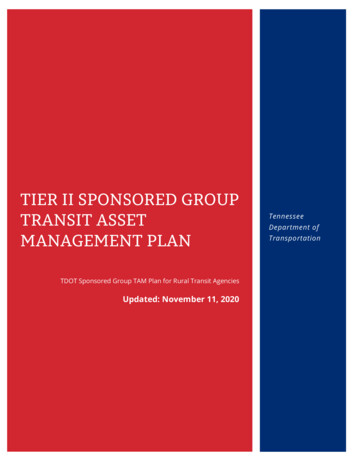
Transcription
TIER II SPONSORED GROUPTRANSIT ASSETMANAGEMENT PLANTDOT Sponsored Group TAM Plan for Rural Transit AgenciesUpdated: November 11, 2020TennesseeDepartment ofTransportation
AcknowledgementsTennessee Department of TransportationSuzanne Carlson, Multimodal Transportation DirectorLarry Sanborn, Multimodal Assistant DirectorKaitlyn McClanahan, Transportation ManagerGeorge Mitchell, Transportation Compliance Program SupervisorChristopher Broach, Transit Asset Control Program MonitorPatsy Mimms, Strategic Planning DirectorJulie Carmean, Strategic Planning Manager1
Plan Participant Transit Asset Management Accountable ExecutivesStephen Seibert, Delta Human Resource Agency (DHRA)Brent Gagley, East Tennessee Human Resource Agency (ETHRA)Candace Gump, First Tennessee Human Resource Agency (FTHRA)Buddy Parton, City of Gatlinburg/Gatlinburg Mass Transit System (GMTS)Anna Perry, Mid-Cumberland Human Resource Agency (MCHRA)Janet Moore, Northwest Tennessee Human Resource Agency (NWTHRA)Lynn Wilhoite, City of Pigeon Forge/Pigeon Forge Fun Time Trolley (PFFTT)Jenny Green, South Central Tennessee Development District (SCTDD)Chris Kleehammer, Southeast Tennessee Human Resource Agency (SETHRA)Diana Turner, Southwest Human Resource Agency (SWHRA)Holly Montooth, Upper Cumberland Human Resource Agency (UCHRA)2
Table of ContentsIndex of Tables. 4ACRONYMS AND DEFINITIONS . 5CHAPTER 1: INTRODUCTION . 91.1Overview . 91.2Transit Providers. 101.3TAM Plan Requirements/Compliance . 101.4State of Good Repair Performance Measure . 12Chapter 2: Asset Inventory . 142.1Data Collection . 142.2Rolling Stock . 142.3Equipment (Non-Revenue Service Vehicles). 162.4Facilities . 17Chapter 3: DECISION SUPPORT TOOLS . 193.1Rolling Stock and Equipment (Non-Revenue Service Vehicles) . 193.2Facilities . 223.3ASSET CONDITION RESULTS. 243.3.1Rolling Stock . 243.3.2Equipment (Non-Revenue Service Vehicles) . 263.3.3Facilities. 28Chapter 4: INVESTMENT PRIORITIZATION . 294.1Current Funding Level Trends. 294.2Prioritized List of Investments . 30Chapter 5: National Transit Database (NTD) . 31Chapter 6: Plan Updates and Conclusions . 32Appendices . 333
Index of TablesTable 1: TERM Scale . 12Table 2: FTA/NTD & TDOT Sponsored Plan State of Good Repair Targets . 13Table 3: Data Inventory . 14Table 4: Rolling Stock Assets by Transit Provider . 15Table 5: Rolling Stock Assets by Asset Type . 15Table 6: Non-Revenue Service Vehicles by Transit Agency . 16Table 7: Facilities with Participant Direct Capital Responsibility . 18Table 8: Decision Support Tool Benchmarks . 19Table 9: Condition Rating for Rolling Stock . 20Table 10: Replacement Criticality Scale. 21Table 11: SGR for Rolling Stock Based on ULB . 24Table 12: SGR for Rolling Stock by Asset Based on ULB . 24Table 13: TDOT TAM Score for Rolling Stock . 25Table 14: SGR Non-Revenue Service Vehicles based on ULB . 26Table 15: SGR Non-Revenue Service Vehicles based on Class . 26Table 16: TDOT TAM SCORE for Non-Revenue Service Vehicles . 27Table 17: Facility TERM Ratings . 28Table 18: Current Projected Funding per 2020-2023 Draft STIP . 29Table 19: TAM Plan Update Record . 324
ACRONYMS AND DEFINITIONSAccountable Executive: Means a single, identifiable person who has ultimateresponsibility for carrying out the safety management system of a public transportationagency; responsibility for carrying out transit asset management practices; and control ordirection over the human and capital resources needed to develop and maintain both theagency’s public transportation agency safety plan, in accordance with 49 U.S.C. 5329(d), andthe agency’s transit asset management plan in accordance with 49 U.S.C. 5326.Asset Category: Means a grouping of asset classes, including a grouping of equipment, agrouping of rolling stock, a grouping of infrastructure, and a grouping of facilities.Asset Class: Means a subgroup of capital assets within an asset category. For example,buses, trolleys, and cutaway vans are all asset classes within the rolling stock assetcategory.Asset Inventory: Means a register of capital assets, and information about those assets.Capital Asset: Means a unit of rolling stock, a facility, a unit of equipment, or an element ofinfrastructure used for providing public transportation.Decision Support Tool: Means an analytic process or methodology: (1) To help prioritizeprojects to improve and maintain the state of good repair of capital assets within a publictransportation system, based on available condition data and objective criteria; or (2) Toassess financial needs for asset investments over time.Direct Recipient: Means an entity that receives Federal financial assistance directly fromthe Federal Transit Administration.Equipment: Means an article of nonexpendable, tangible property having a useful life of atleast one year.Exclusive-Use Maintenance Facility: Means a maintenance facility that is not commercialand either owned by a transit provider or used for servicing their vehicles.Facility: Means a building or structure that is used in the support of public transportation.5
FTA/NTD TAM Target: means the percentage of vehicles that have met or exceeded theiruseful life benchmarkFull Level of Performance: Means the objective standard established by FTA fordetermining whether a capital asset is in a state of good repair.Horizon Period: Means the fixed period within which a transit provider will evaluate theperformance of its TAM Plan. FTA standard horizon period is four years.Implementation Strategy: Means a transit provider’s approach to carrying out TAMpractices, including establishing a schedule, accountabilities, tasks, dependencies, and rolesand responsibilities.Investment Prioritization: Means a transit provider’s ranking of capital projects orprograms to achieve or maintain a state of good repair. An investment prioritization isbased on financial resources from all sources that a transit provider reasonably anticipateswill be available over the TAM Plan horizon period.Key Asset Management Activities: Means a list of activities that a transit providerdetermines are critical to achieving its TAM goals.Participant: Means a Tier II provider that participates in a group TAM Plan.Performance Measure: Means an expression based on a quantifiable indicator ofperformance or condition that is used to establish targets and to assess progress towardmeeting the established targetsPerformance Target: Means a quantifiable level of performance or condition, expressed asa value for the measure, to be achieved within a time period required by the FederalTransit Administration (FTA).Public Transportation System: Means the entirety of a transit provider’s operations,including the services provided through contractors.Recipient: Means an entity that receives Federal financial assistance under 49 U.S.C.Chapter 53, either directly from FTA or as a subrecipient.Replacement Criticality Scale: Means the value on the TDOT Replacement Criticality Scalefor how critical a vehicle is for an agency’s operations. This value is used as an additionalfactor in helping agencies to determine replacement vehicle priorities.6
Rolling Stock: Means a revenue vehicle used in providing public transportation, includingvehicles used for carrying passengers on fare-free services.Service Vehicle: Means a unit of equipment that is used primarily either to supportmaintenance and repair work for a public transportation system or for delivery ofmaterials, equipment, or tools.State of Good Repair (SGR): Means the condition in which a capital asset is able to operateat a full level of performance.Subrecipient: Means an entity that receives Federal transit grant funds indirectly through aState or a direct recipient.TDOT TAM Score: the combined average of a vehicle’s agency submitted conditioning,useful life, and mileage. These values are based on scales of 1-5 with the lower numberrepresenting a greater need and/or age.TDOT TAM Target: Means the percentage of vehicles that have an average combined TAMscore of “3” or lessTERM Scale: Means the five (5) category rating system used in the Federal TransitAdministration’s Transit Economic Requirements Model (TERM) to describe the condition ofan asset: 5.0—Excellent, 4.0—Good; 3.0— Adequate, 2.0—Marginal, and 1.0—Poor.Tier II Provider: Means a recipient that owns, operates, or manages (1) one hundred (100)or fewer vehicles in revenue service during peak regular service across all non-rail fixedroute modes or in any one non-fixed route mode, (2) a subrecipient under the 5311 RuralArea Formula Program, (3) or any American Indian tribe.Transit Asset Management (TAM): Means the strategic and systematic practice ofprocuring, operating, inspecting, maintaining, rehabilitating, and replacing transit capitalassets to manage their performance, risks, and costs over their life cycles, for the purposeof providing safe, cost-effective, and reliable public transportation.Transit Asset Management (TAM) Plan: Means a plan that includes an inventory of capitalassets, a condition assessment of inventoried assets, a decision support tool, and aprioritization of investments.Transit Provider (provider): Means a recipient or subrecipient of Federal financialassistance under 49 U.S.C. Chapter 53 that owns, operates, or manages capital assets usedin providing public transportation.7
Useful life: Means the minimal acceptable period of use in service determined by FTA.Useful life benchmark (ULB): Means the acceptable period of use in service for a capitalasset, as determined by the default benchmark provided by FTA.8
CHAPTER 1: INTRODUCTION1.1OverviewTransit Asset Management (TAM) is a business model that prioritizesfunding based on the condition of transit assets in order to achieve ormaintain transit networks in a State of Good Repair (SGR).In 2012, in order to address the capital needs of public transit systemsacross the country, the Moving Ahead for Progress in the 21st Century (MAP21) legislation mandated the creation of a TAM system to be implemented bythe Federal Transit Administration (FTA). On July 26, 2016, the FTA publishedrequirements that became effective October 1, 2016 which would establish‘‘a strategic and systematic process of operating, maintaining, and improvingpublic transportation capital assets effectively through the life cycle of suchassets.’’ 49 U.S.C. 5326(a)(3). These requirements state that each agency mustdevelop a Transit Asset Management (TAM) Plan it if owns, operates ormanages capital assets used to provide public transportation and receivesfederal financial assistance under 49 U.S.C. Chapter 53 as a recipient orsubrecipient.As the State Department of Transportation that serves as the administrator andrecipient of FTA funds, the Tennessee Department of Transportation (TDOT)opted to sponsor a Group Transit Asset Management (TAM) Plan for their Tier IIsubrecipient agencies that receive Section 5311 Rural Area Formula Programfunding. All eleven of TDOT’s rural providers qualify as Tier II operators and arepart of the TDOT Group TAM Plan as described in Section 1.2.9
Transit Providers1.2This Group TAM Plan covers eleven rural transit systems in Tennessee. Ninetransit providers (eight human resource agencies and one developmentaldistrict) cover regional rural transportation needs in 94 of 95 counties in thestate and two locally operated rural transit providers (Gatlinburg and PigeonForge) that operate in the tourist areas of Sevier County. The 11 agenciescombined provide demand response, flex route, and fixed route services.1.3TAM Plan Requirements/ComplianceThe Group Transit Asset Management (TAM) Plan will fulfill the requirements ofthe Federal Transit Administration’s (FTA) Final Rule, Volume 81, No. 143, onTransit Asset Management. The rule encompasses a state of good repair and thedata collection, prioritization, and data delivery to the National Transit Database(NTD).A Tier II Group TAM Plan includes four (4) elements of the Final Rule as follows: Inventory of Capital Assets: An inventory of the number and type of capitalassets to include: rolling stock, facilities, and equipment - 49CFR§625.25 (b)(1)10
Condition Assessment: A condition assessment of those inventoried assets forwhich the transit provider has direct ownership and/or capital responsibilities 49CFR§625.25 (b)(2) Decision Support Tools: A description of the analytical processes and decisionsupport tools that the Authority uses to estimate capital investment needs overtime, and develops its investment prioritization - 49CFR§625.25 (b)(3) oritizationofinvestments. - 49CFR§625.25 (b)(4)The implementation deadline for the TAM Plan to become effective is October 1,2018. The TAM Plan must cover a horizon period and be updated in its entiretyat least four years. The Plan can be amended as needed, or when there is asignificant change to the asset inventory, condition assessment or investmentprioritization.In addition to the TAM Plan, the TAM Final Rule requires the submission of twoadditional reports to the FTA’s National Transit Database (NTD) with the annualreporting package. The Data Report should describe the condition of the transportationsystem currently and the SGR performance targets for the upcoming year The Narrative Report, which will be required beginning in FFY 2019, shoulddescribe the changes in the transportation system condition and reportprogress on meeting the performance targets from the prior year, anddescribe any revisions to the established goals.Each transit provider must designate an Accountable Executive to ensureappropriateresourcesforimplementing the agency’s TAM Plan. TheAccountable Executive of each participating agency is expected to approve thePlan and is ultimately responsible for implementation of the Plan at theparticipant agency.11
1.4 State of Good Repair Performance MeasureEach agency is required to establish annual State of Good Repair (SGR)performance measures and targets for each asset category. As the groupsponsor, TDOT has established statewide targets. Participating agencies maydevelop more restrictive targets. TDOT will report on the statewide targets forSGR measures in the following asset categories: Rolling Stock (revenue vehicles): Percent of vehicles that have either metor exceeded their Useful Life Benchmark (ULB). Condition ratings forvehicles are expressed in terms of the percentage of assets that are at orbeyond the ULB -based on FTA Circular 9030.1D, paragraph 4a. Equipment (including non-revenue service vehicles): Percent of assetsthat have either met or exceeded their ULB. Facilities: Percent of facilities rated below condition 3 on the FTA TERMscale shown in Table 1.Table 1: TERM Scale No visible defects, new or near new condition May still be under warranty (if applicable) Good condition, but no longer new, may be slightly defective or deteriorated, but is overall functionalAdequate Moderately deteriorated or defective; but has not exceeded useful life2Marginal Defective or deteriorated in need of replacement; exceeded useful life1Poor Critically damaged or in need of immediate repair; well past useful life5Excellent4Good312
TDOT established the following SGR targets for rolling stock and equipment (i.e. nonrevenue service vehicles) effective January 1, 2018 and submitted them to the FTA, as wellas provided them to all Tennessee Metropolitan Planning Organizations for reference inthe establishment of their MPO goals.Table 2: FTA/NTD & TDOT Sponsored Plan State of Good Repair TargetsRolling StockTDOT utilizes the FTA default ULB for revenue vehicle targets. FTA/NTD State of GoodRepair targets are based only on vehicles that have met or exceeded the useful lifebenchmark for their vehicle type. The State of Good Repair targets used for the TAM Planare for vehicles with an overall average TDOT TAM Score of “3” or less. Both sets of targetsrepresent that no more than the listed percentages will meet these criteriaVehicle TypeAutomobile (AO)Bus (BU)Cutaway Bus (CU)Minivan (MV)Other Rubber Tire (OR)Van (VN)Useful LifeBenchmarkFTA/NTDTargetsTDOT TAMScore Target81410814850 %15 %10 %25 %0%15 %50 %10 %15 %30 %0%30 %Equipment (Non-Revenue Ser
opted to sponsor a Group Transit Asset Management (TAM) Plan for their Tier II subrecipient agencies that receive Section 5311 Rural Area Formula Program funding. All eleven of TDOT’s rural providers qualify as Tier II operators and are part of the TDOT Gro

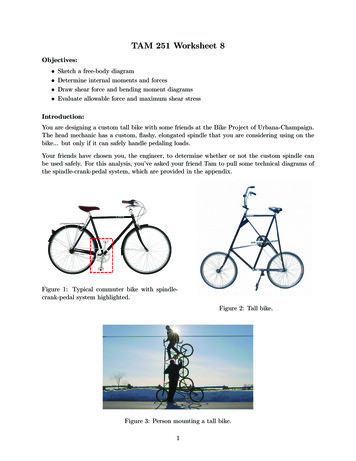
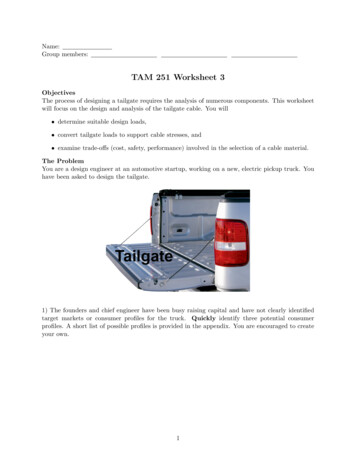
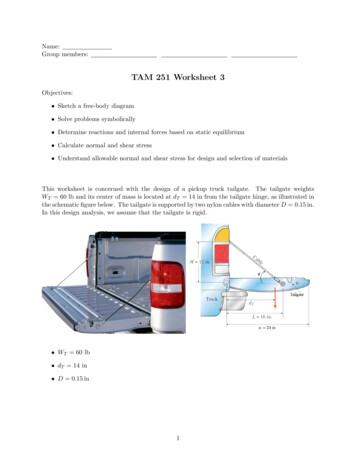
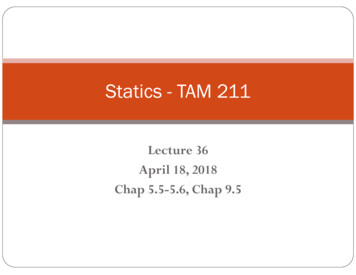
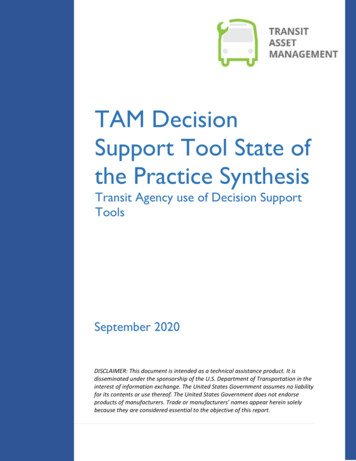
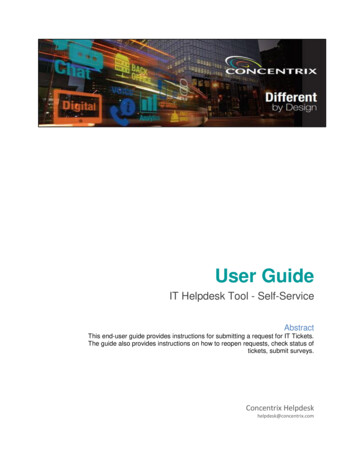
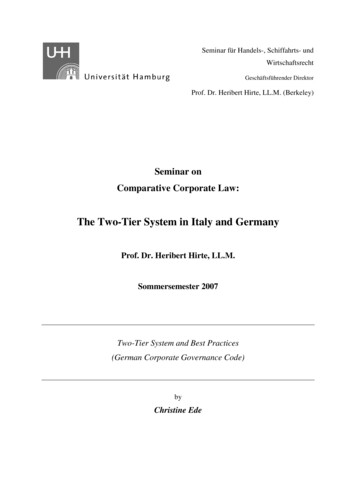

![Tier 1 Chiropractic Directory [as of April 2018]](/img/8/chiropractic-tier1.jpg)
